WYKEHAM HENRY KOBA FREAME, DCM
an ANZAC in the family
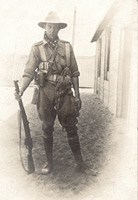
(thumbnails are links to larger files)
Page 2 |
|
Henry enlisted in Kensington, near Sydney, at what appears to be the first opportunity, on the 28th August. Presumably to ensure that he was accepted, he shaved 5 years off his age and said that he was a British subject, born in Canada. At that time, many men enlisting in England were well under 5ft 6ins. whereas Henry was just over 5ft 10 ins. and weighing in at just over 10 stone. His eyes were brown, he was dark complexioned and his hair was dark. He probably spoke with a strong accent which would add to his exotic appearance (later speculation suggested that he was part Mexican). His next of kin is named as Edith May Freame, of North Ormesby, Yorkshire [2]. I imagine that denying his own Japanese heritage would not be easy for him but he needed to be sure he would be accepted for the Australian Imperial Force. And he was - as a private, number 764, in the 1st Battalion.
He went into training with the rest of his Battalion, at Kensington Race Course (near Sydney). Reading the War Diaries we can see that training seems to follow much the same pattern wherever it happens : musketry/rifle handling, marching, drill and digging. However, there was a bit of variety on the 9th September as there was a Race Meeting organised so the tents had to be down by 9am and the men marched away to the rifle range. The rather despondent comment in the Diary reads, 'Musketry was confined to grouping practice. Results were only moderate as men were unacquainted with rifles.' [14]
Training continued much as before and, on the 23rd September, orders were received for embarkation on the 27th ... but 2 days later it was delayed ... and training continued; this time to include, 'training in outposts', 'training in fire control', and 'attack on a position'. There was the regular church parade on Sunday and Brigadier's inspections. 680 men had medical examinations and of these just 12 were declared unfit and rejected.
A month later, on the 17th October, bags and baggage were finally loaded on board the SS Affric and on the following day camp was cleared and the men marched to Fort Macquarie where embarkation was 'completed by noon in good order'. Life settled into a shipboard routine: they were 'instructed in ship's discipline - no cases of drunkeness', a library was organised with a YMCA representative, physical training and rifle exercises were started and there was a concert on the 20th. There were kit inspections and lectures on semaphore. On the 30th, at Albany, there must have been what seemed a welcome break from the confines of the ship - a route march of 6 and a half miles. The next morning brought some unwelcome excitment with an 'alarm of fire in No. 6 hold among stores. Soon got under. Men fell in well on fire stations.' Early next morning the convoy set sail again.
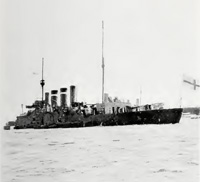
HMAS 'Sydney' |
Welcome news, for anyone on board an allied ship, was received on the 9th November, that the German cruiser, SMS 'Emden' had been permanently put out of action by HMAS Sydney. This German battle cruiser had harried and sunk allied shipping in the Indian Ocean since the outbreak of war. The destruction of this enemy ship, which would have posed a threat to their own safety on the high seas, must have lightened the mood on board considerably! |
Sailing on they eventually reached Alexandria and began disembarking for the journey to Cairo where they would complete their training at Mena Camp, in Egypt, which they reached without apparent incident on the 9th December. Only days before their arrival the camp had been a mere score of tents but, in the days that followed, battalion after battalion arrived, and the camp mushroomed in size.
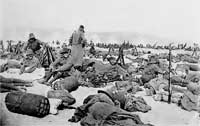
First tents in the Mena Desert
Camp, 4th December 1915
|
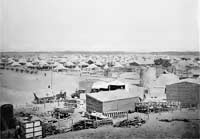
Mena Desert Camp 1915
|
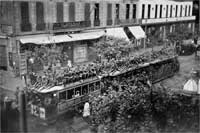
Australian troops coming into
Cairo from the camps
|
'Day after day, enthralled, I watched this encampment growing and spreading out on either side of the road, creeping up the sides of the hills, stretching out across the desert, until the furthermost tents looked like tiny white-peaked triangles set in the yellow sand. The battalions filed into their places coming from the seaboard, where twelve ships at a time were discharging their human cargoes; while each day ten trains brought the troops up 130 miles to the desert camps. After the men came the gear, the wagons, the guns, the horses. For this was the divisional camp, the first divisional camp Australia had ever assembled.'
[12. p 69 'Australia in Arms']
For many of these allied troops, from far flung points of the globe everywhere between Manchester in England and the southern tips of Australia and New Zealand, it would have been their first opportunity to see new and exotic places. Excitement must have run high as the pyramids appeared in the distance ... they would have been impatient to see and experience everything there was.
'It would be out of place just at the moment to bring any dark shadow across the bright, fiery path of reckless revelry that the troops embarked on during the week preceding and the week following Christmas. It was an orgy of pleasure, which only a free and, at that time, unrestrained city such as Cairo could provide. Those men with £10 to £20 in their pockets, after being kept on board ship for two months, suddenly to be turned loose on an Eastern town - healthy, keen, spirited, and adventurous men - it would have been a strong hand that could have checked them in their pleasures, innocent as they were for the most part.
In all the camps 20 per cent, leave was granted. That meant that some 6,000 soldiers were free to go whither they wished from afternoon till 9.30 p.m., when leave was supposed to end in the city. Now, owing to lax discipline, the leave was more like 40 per cent., and ended with the dawn. Each night - soft, silky Egyptian nights - when the subtle cloak of an unsuspected winter hung a mantle of fog round the city and the camps - 10,000 men must have invaded the city nightly, to which number must be added the 2,000 Territorial troops garrisoning Cairo at the time that were free, and the Indian troops, numbering about 1,000.
The majority of the men came from Mena and from the New Zealand camp at Zeitoun. The Pyramids Camp was linked to the city by a fine highway (built at the time of the opening of the Canal as one of the freaks of the Empress Eugenie), along the side of which now runs an electric tramway. Imagine officials with only a single line available being faced with the problem of the transport of 10,000 troops nightly to and from the camps ! No wonder it was inadequate. No wonder each tram was not only packed inside, but covered outside with khaki figures. Scores sat on the roofs or clung to the rails. Generally at three o'clock the exodus began from the camps. What an exodus ! What spirits! What choruses and shouting and linking up of parties!
Here was Australia at the Pyramids. Men from every State, every district, every village and hamlet, throughout the length and breadth of the Commonwealth, were encamped, to the number of 20,000, in a square mile. An army gains in weight and fighting prowess as it gains in every day efficiency by the unitedness of the whole. Now, the true meaning of camaraderie is understood by Australians, and is with them, I believe, an instinct, due to the isolated nature of their home lives and the freedom of their native land. When the troops overflowed from the trams, they linked up into parties and hired motor-cars, the owners of which were not slow to appreciate the situation. They tumbled ten or twelve into these cars, and went, irrespective of speed limits, hooting and whirring towards the twinkling city. And when the motors gave out, there was a long line of gharries (arabehs), which are open victorias, very comfortable, and with a spanking pair of Arab steeds, travelling the 10 miles to the city.
So much was novel, so much strange and entrancing in this city of Arabian fables. Cairo presents the paradox of the Eastern mind, and the reverse nature of events and incidents amused and excited the imaginations of the Australians.'
[p 71/72 'Australia in Arms']
Was Henry similarly enthused? After all, he'd spent most of the last 20 years voyaging across the world's oceans, between foreign shores, including the Black Sea, access to which would have been through the Dardanelles. Presumably he'd spent time ashore in many foreign ports and perhaps there was little novelty, here, for him.
At the beginning of January 1915 Henry had proved his ability and been promoted to Lance Corporal. The days in camp were long and full but interspersed with a 'day's holiday' at regular intervals. The training now was involving attacking and defending positions and trenches, mock attacks by different brigades on each other, night operations, and so on.
In the meantime, Turkey entered the war on the side of the Germans and contol of the Dardanelles, gateway to the Black Sea and important as a Russian supply route, became of great strategic importance. The Allies needed the Gallipoli peninsula in their hands to ensure safe passage for allied shipping. However, the Turkish forces had come under the command of a German officer, Otto Liman von Sanders who, assessing the situation, saw the danger and began bringing up thousands of Turkish soldiers, placing them at gun posts along high points overlooking any possible allied landing places on the peninsula. The Allied powers-that-be didn't appear to expect, or have contingency plans to counter, an efficient, strong and co-ordinated resistance from the Turkish forces.
By April, Henry had been the battalion scout for a number of months and was gaining a reputation for being both successful and resourceful. It was at the end of this month that Henry was promoted to 'sergeant'.
The scene was set.
On the 2nd April came the order once again to prepare for embarkation. They returned to Alexandria and on 4th April embarked on the SS 'Minnewaska' as part of the MEF (the Mediterranean Expeditionary Force, which also included British and French servicemen) . On the 10th April the ship set sail for Mudros, arriving 2 days later. It was here, on the island of Lemnos, that they practised embarking and disembarking from boats.
What would have been Henry's thoughts and emotions when he found himself back in those very same waters of the Dardanelles which he had last seen, as a crewman, from the deck of the SS 'Lady Gray' in 1904 as it passed through the Straits to the Black Sea and trade in its ports?
The war diary tells us that, on the 24th April they left Mudros for Gaba Tepe where, the following day, 25th, they 'landed without loss'.
They were certainly the lucky ones ...
The 1st Battalion, on the Minnewaska, hadn't been in the first wave of those landing. Some of the towing-boats in the convoy (with their floating 'barges' packed with soldiers) had drifted off course and landed on a beach a little to the north of their intended destination. This was the tiny beach that would go down in history as Anzac Cove. All along the peninsula hundreds of men were being landed on beaches overlooked by the enemy and many faced with steep escarpments to climb before they could even begin to engage in actual battle with the enemy. For many it became a massacre as hundreds died, straight from training, without ever firing a bullet in anger; mown down by machine-gun fire as they waded ashore, or were even killed in the barges before they had managed to climb over the side into the water.
However, for Wykeham Henry Freame and the 1st Battalion, in the early morning of 25th April, we can read, in 'The Official History of Australia in the War of 1914-1918' that ...
'Meanwhile, in the Minnewaska's saloon, the officers’ breakfast was proceeding. the flashes of the warships’ guns every now and then showing through the portholes. The oldest steward had swept the carpet as usual, and, napkin on arm, was placing the menu before his passengers and asking if they preferred eggs or fried fish after their porridge.
Until 7 a.m. those in the transports had no idea as to whether the Ianding had succeeded. The constant burst of shells on Plugge’s, and the small boats far ahead- returning singly and rather aimlessly from the beach, gave the impression that fighting was still heavy near the shore. About 7 o’clock. in the growing light, the anxious watchers along the ships’ rails made out the forms of men digging, walking, and apparently talking together unconcernedly upon the high ridges ahead.
There was no mistaking that casual gait-it was a sure sign throughout the war. They were Australians. Lines of them were digging in on the first and second ridges beyond the beach. The 3rd Brigade had established itself on the land. Between 5.30 and 7.30 the 2nd and 1st Brigades of the 1st Australian Division began to move ashore.'
(7. p.279 in Vol. 1 of 'The Official History of Australia in the War of 1914-1918' by C.E.W.Bean)
In 'Australia in Arms' we read that ...
'at 2.30 a.m. the transports, together with the tows and the destroyers, steamed in to within 4 miles of the coast. The moon was sinking slowly, and the silver haze it cast in the heavens, back of the island of Imbros, may have silhouetted the ships dimly and served as a warning for the Turks. Probably the ships came undetected, but no sight of land could be seen, not even a signal light. From the battleship 'Queen', lying but a mile off the promontory of Gaba Tepe, all directions were given and the attack commanded...
Only a general idea of the shore on which the army corps was to set foot had been gained by the leaders from the decks of warships. It revealed to them, just north of Gaba Tepe, a short strip of beach, little more than a hundred yards in length, with a low plain behind it, out of which rose up the ridges and foothills, ending in the great ridge of Sari Bair and culminating in Koja Chemin Tepe (Hill 971), the objective of the Army Corps. There was to be a descent on this beach, so it was planned, and a turn north-east up along a plateau or ridge that rose rapidly to the crowning hill. Gaba Tepe itself was a headland in which the' Turks had concealed batteries of machine guns to enfilade this landing and other beaches, but which same point had served for weeks as a good target for the warships. This point was to be stormed and held.
The 21/2 knot current that sweeps along the coast from the mouth of the Straits, bore the bows of heavily laden but shallow draft lifeboats and barges down the Gulf farther than was intended, and so the landing beach was mistaken in the dark. The attack once launched, there was no withdrawal or remedy, so the troops began to pour ashore a mile farther along the coast to the north than was intended; not, on landing, to reach a plain, but to be faced with terrible hills and deep ravines. But was it so awful an error? Chance had carried in her womb a deeply significant advantage, for at the original point the beach had been carefully prepared with barbed -wire, that ran down into the very water. Trenches lined the shore - making similar obstacles to those the British troops faced 9 miles away at Helles. So Chance guided the boats into a natural cove, certainly not very large - just a segment of a circle some 400 yards long. Never anticipating an attack at the foot of such a ridge, the Turks had dug but few trenches to protect this spot, more so as the whole of the beach might be commanded by machine guns, concealed in certain knolls.'
[7. pps 102/103 Australia in Arms' by Phillip F.E. Schuler]
Training was over - it was now the real thing. The Forces that reached shore, and the higher ground, began to dig in for what turned into a protracted campaign instead of the quick and decisive operation envisaged by Allied Command. Conditions were appalling, iron-hard ground to be dug, little cover and the devastating heat of the coming summer. As the weeks dragged by, there was a heavy toll of death, from disease, inconclusive assaults and enemy action. As winter, with heavy rains and frost set in, the long-delayed decision was taken to withdraw and evacuate the peninsula. Preparations were done carefully, without giving any indication of purpose to the enemy and, by 9th January, 1916, Suvla, Anzac and Helles had all been evacuated with a minimal loss of life.
In the 9 months of the campaign, 46,000 allied servicemen had died in the unsuccessful campaign.
However, back to Henry and early morning on the 25th April, 1915, the first day of the campaign ...
|